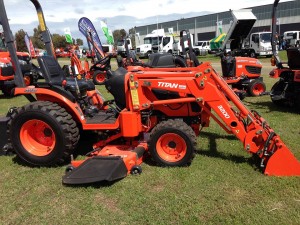Print a Sign-In Sheet | Spanish Version
Industrial/commercial mowers are generally large, heavy pieces of equipment that can be dangerous if not operated properly. Each year, thousands of people are rushed to hospitals for injuries sustained in mowing accidents. Some injuries, especially those caused by equipment tipping over, can be fatal.
Here are some suggestions that can help avoid accidents:
Be familiar with the equipment.
Safe use of industrial and commercial mowers depends on an understanding of each machine’s capacity and operating characteristics. Employees should read the operator’s manual before using the equipment. They should know how to use the mower or tractor and any accessories. They need to know the safe operating speed, slope capabilities, braking and steering characteristics, turning radius, and operating clearances. Inspect, repair or replace any loose, broken, missing, or damaged parts. Make sure that all guards, shields, and safety signs from the manufacturer are in place.
Don’t operate a machine with missing or damaged protective guards or shields.
Know the area.
Look for dangerous conditions such as holes, drop-offs, steep slopes and ditches. Be aware of objects that could damage or be thrown by the mower.
Consider the height and type of material to be mowed and the terrain over which you will operate. Mow in a pattern that will allow you to travel in a straight line as much as possible.
Protect yourself.
ALWAYS wear steel-toed shoes, protective eyewear, and hearing protection. You should also wear full length, close-fitting clothes and gloves, as well as a hat to block the sun.
Be mindful of others nearby.
Watch out for others. Before starting or moving any piece of equipment, make sure all personnel are a safe distance away. Never let anyone ride along. If someone approaches the area you are mowing, shut off the equipment. An object thrown by a mower could cause serious or fatal injuries.
Safe mowing practices:
- Use a safe ground speed. This speed will depend on the height and density of the material being cut and the nature of the terrain.
- To avoid a rollover, slow down on slopes and when turning sharply. Watch for holes or uneven areas.
- With mid mount, rear mount, pull-type, and wing mowers, always mow down slopes.
- With side mount, offset, and sickle bar mowers, always mow across the slope whenever possible, with the mower on the uphill side. Never operate with the mower pointed downhill.
- Use extreme caution when mowing steep banks.
- Never mow in reverse and always look before backing up.
- Keep feet and hands away from belts and all moving parts.
- When parking the equipment, always disengage power to the mower, set the parking brake, turn off the engine, and remove the key. Always park equipment on level ground.
KEMI does not assume liability for the content of information contained herein. Safety and health remain your responsibility. This information is to be used for informational purposes only and not intended to be exhaustive or a substitute for proper training, supervision or manufacturers’ instructions/recommendations. KEMI, by publication of this information, does not assume liability for damage or injury arising from reliance upon it. Compliance with this information is not a guarantee or warranty that you will be in conformity with any laws or regulations nor does it ensure the absolute safety of any person, place or object, including, but not limited to, you, your occupation, employees, customers or place of business.

